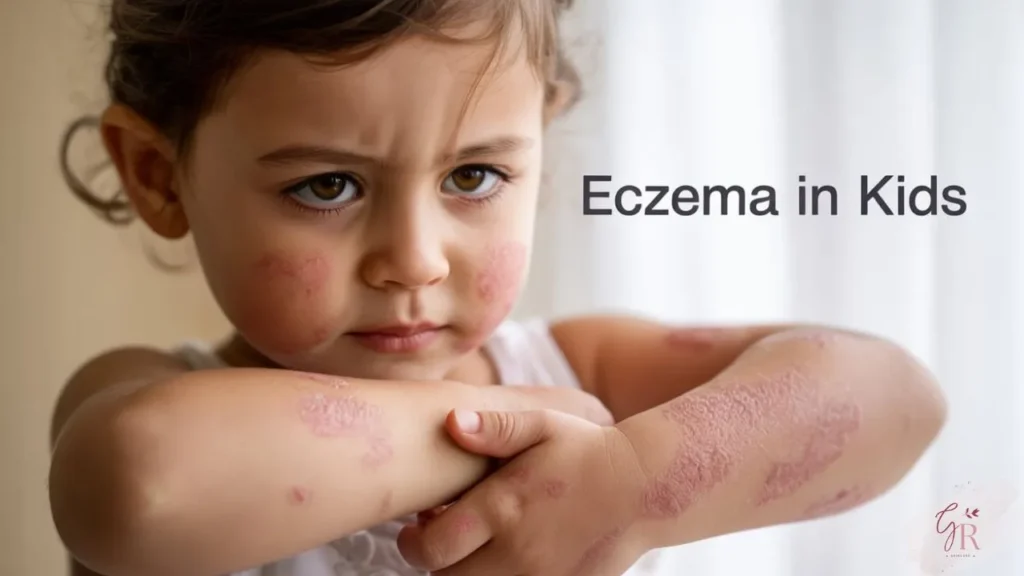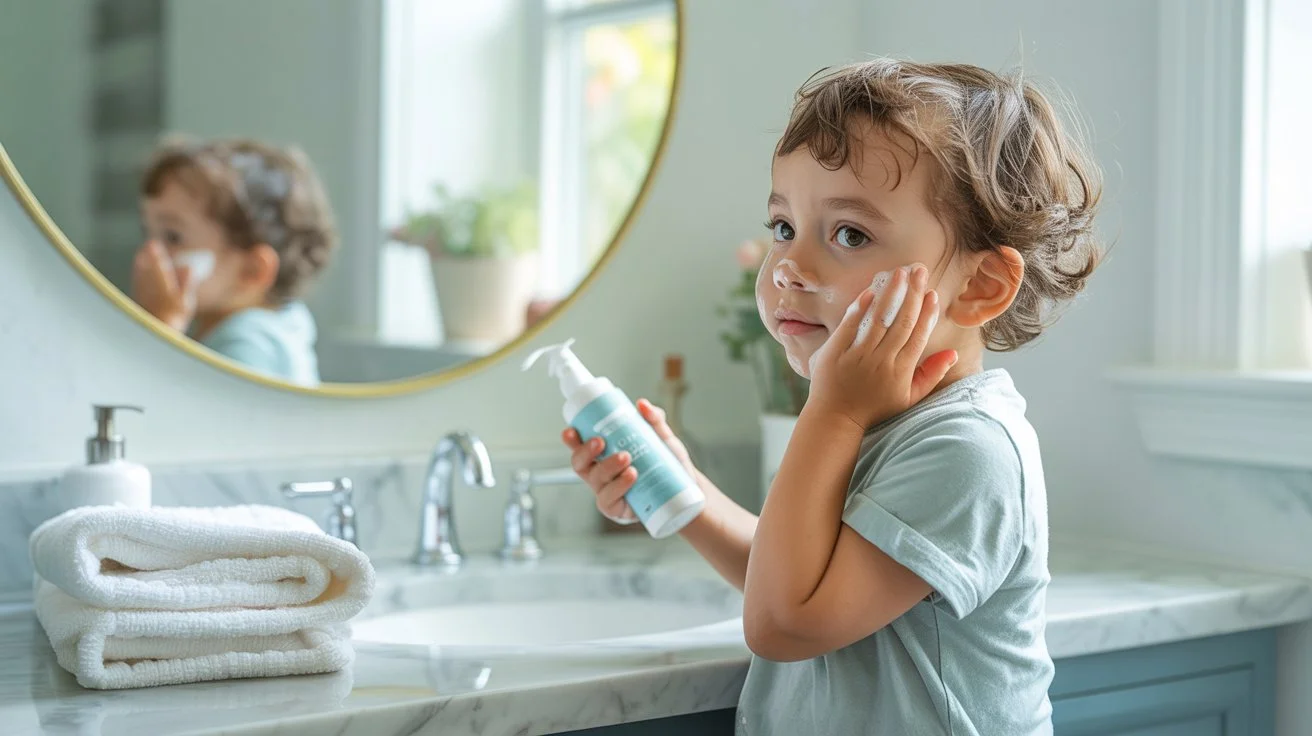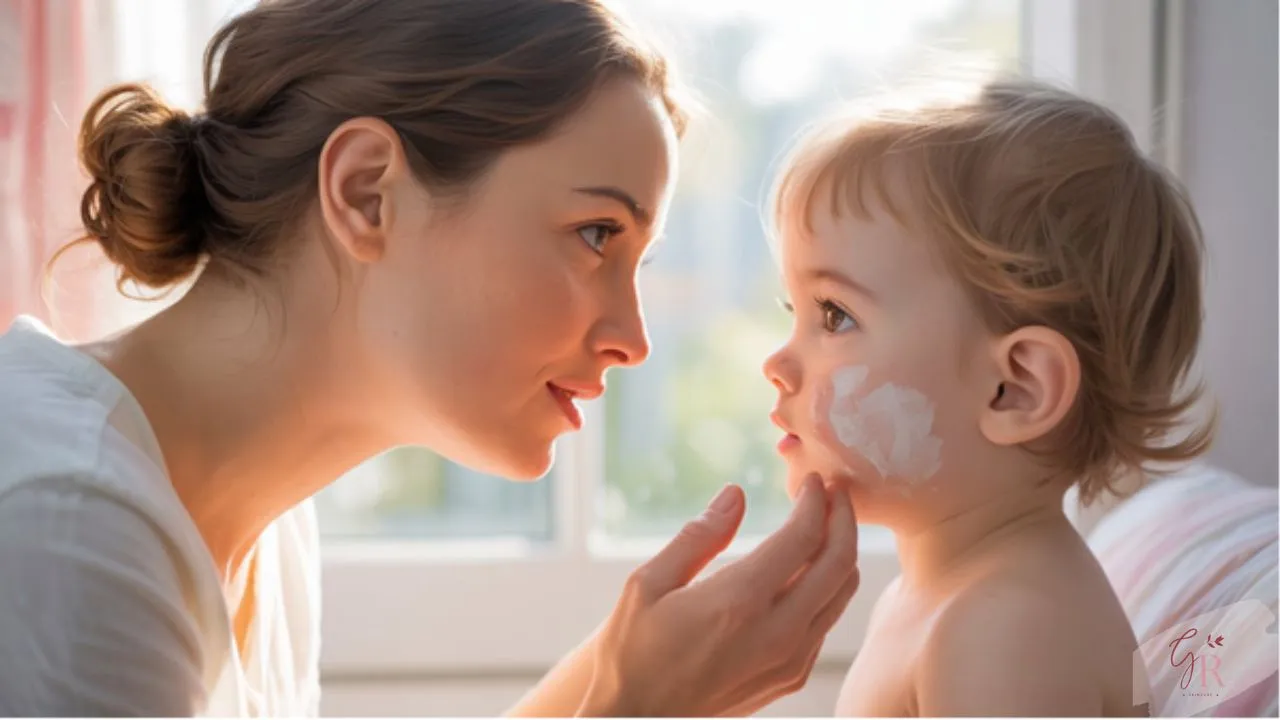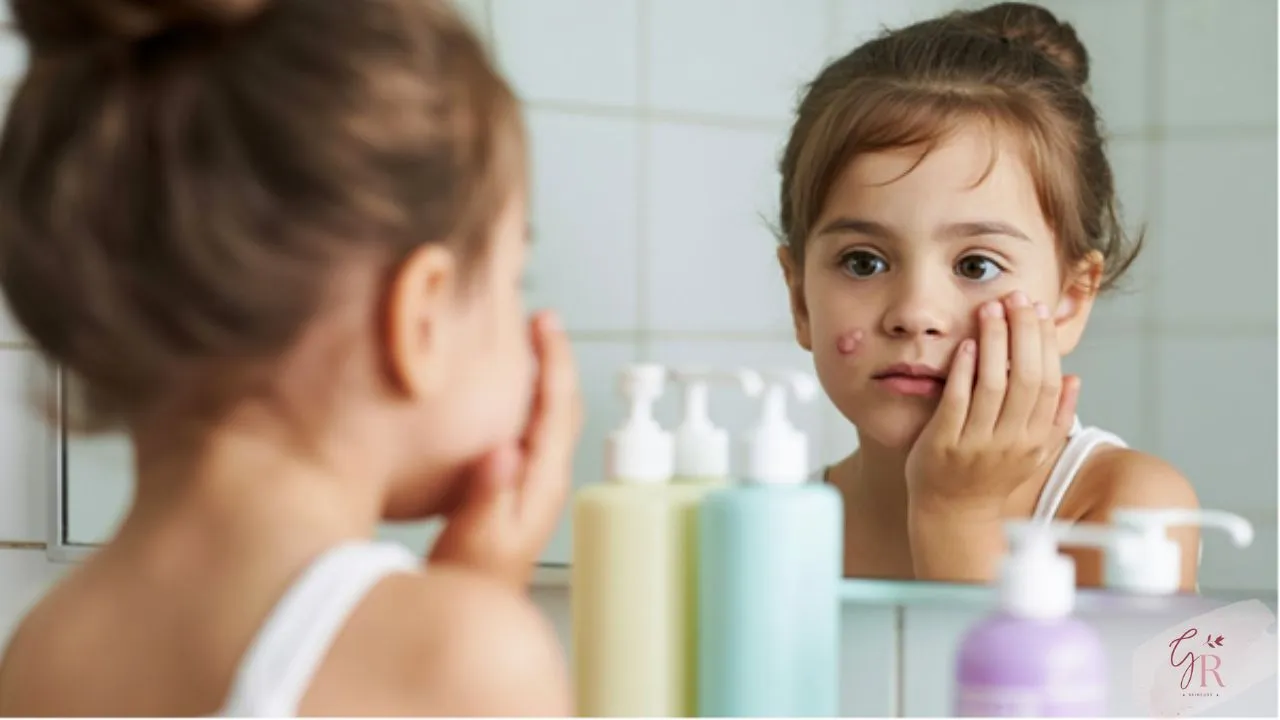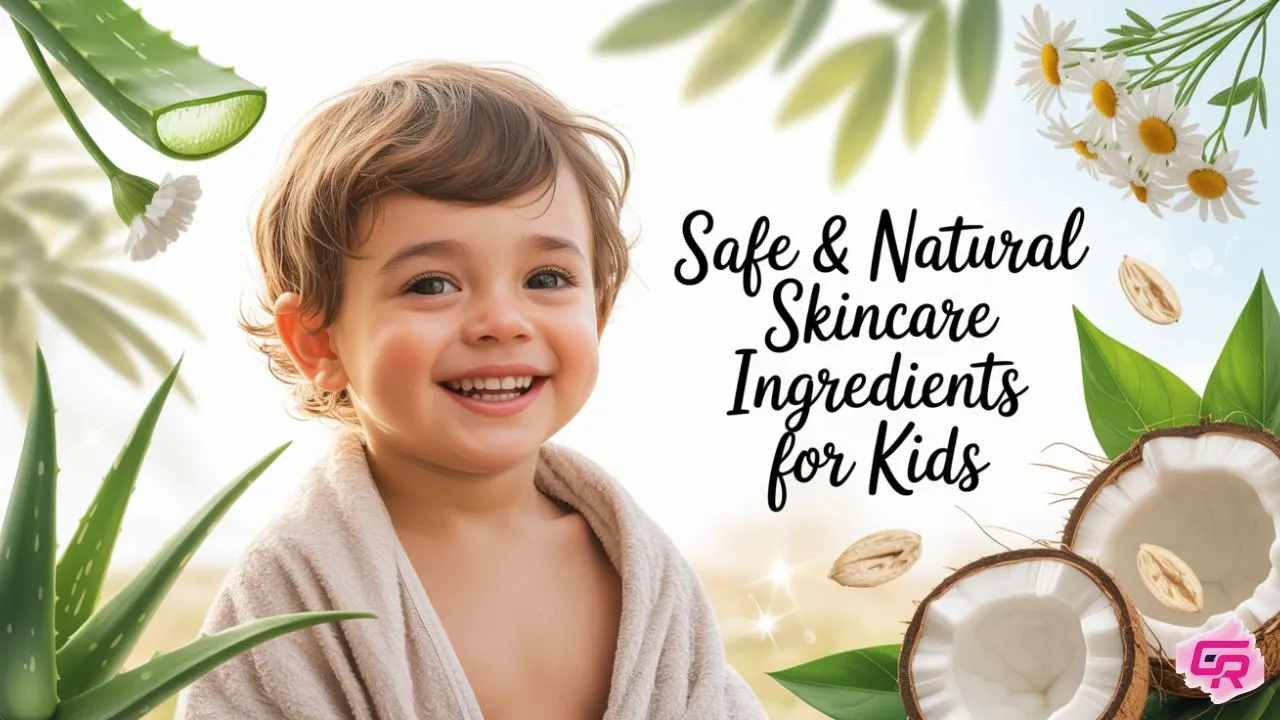Eczema in Kids is becoming very common these days. If your child frequently has dry, red, or itchy skin on their face, hands, or body, it may not be just dryness. It could be eczema. This problem can happen to children of any age and often parents get worried about it, but there is no need to worry. In this article, we will tell you what the first signs of eczema are, understand what causes eczema in kids, what things to avoid, and what easy home remedies can be for it.
What Is Eczema in Kids?
Eczema in kids is a common skin condition that causes dry, itchy, red or swollen patches of skin. It is also called atopic dermatitis. It usually appears in early childhood. A child with eczema has very sensitive skin. Even mild soap, weather or clothing can cause a reaction. This condition is not contagious to others, but it can be a cause of concern for both the child and the parents.
How It Looks on Child Skin
Eczema often looks like this:
- Red or pink dry patches
- Small bumps or blisters filled with fluid
- Cracked or rough skin
- Intense itching, especially at night
- Sometimes the skin oozes or may even bleed if it is scratched too much
The most common areas include the cheeks, behind the knees, elbows, neck, and hands.
Is It Different from Normal Dry Skin?
Yes, eczema is not just about dryness, where dry skin is just slightly flaky or rough. In eczema, the skin is very irritated and itchy. Eczema patches are redder and can become thick and scaly over time. Dry skin can be cured with regular lotions, but proper care and treatment are required to control eczema.
Related: Dry Skin in Kids: Easy Signs Every Parent Should Know
Early Signs and Symptoms of Eczema in Kids
Itchy Red Patches
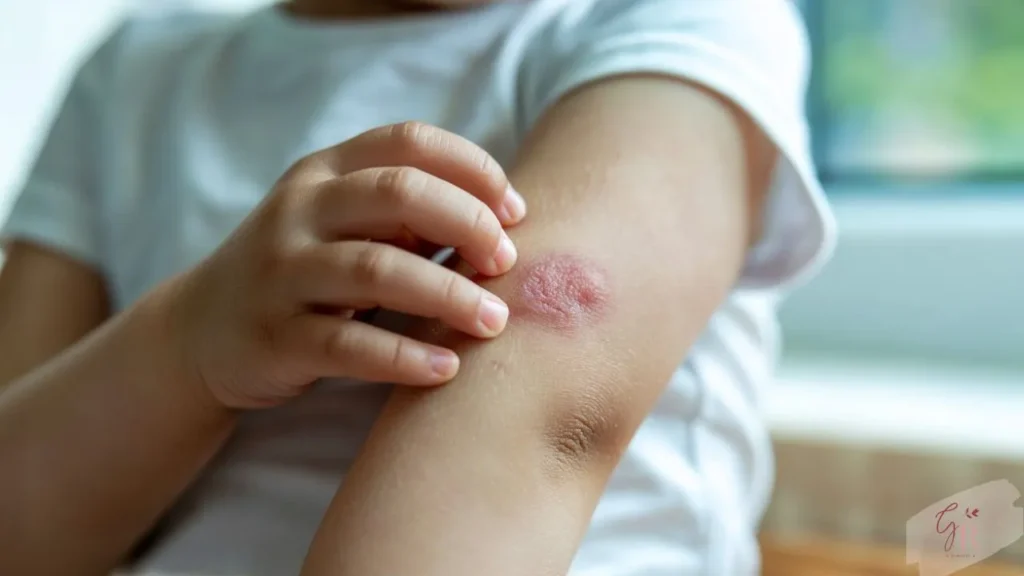
The first sign of eczema in kids is often red spots that are very itchy. Your child will scratch these areas frequently, especially at night. These spots can be flat or slightly raised.
Dry, Scaly or Cracked Skin
Another common symptom is that the skin looks very dry, rough or cracked. You may notice white or gray flakes on your baby’s hands, feet or face. This dryness is not relieved by regular lotion.
Rash Behind Knees, Elbows, Neck
Eczema often occurs in areas where the skin folds, such as behind the knees, inside the elbows, or on the side of the neck. These areas are more affected by heat and sweat, so eczema is more common there.
Irritability & Scratching
Children who have eczema often become irritable or upset because they are constantly itching. You may see them scratching their skin by rubbing it against clothing, bed sheets, or furniture.
Common Causes of Eczema in Children
Eczema in kids doesn’t appear without a reason. Multiple factors can trigger it, especially if your child already has sensitive skin. Here are some common causes.
Family History
If someone in your family has eczema, asthma, or allergies, your child may also have it. This disease is passed down through genes.
Environmental Triggers
Small everyday things can trigger eczema— like:
- Dust or pollen
- Heat and sweating
- Rough or woolen clothes
- Scented soap or washing powder
Ordinary clothes or even a change in weather can irritate the skin.
Weak Skin Barrier
Children with eczema have skin that is unable to retain moisture, which causes
- Dry, flaky skin
- Easy irritation
- Bathing or cold air can make the skin worse
Food Allergies
Sometimes eczema is also aggravated by certain foods, such as:
- Cow’s milk
- Eggs
- Peanuts
- Soy or wheat
Not every child has a food allergy, but if eczema seems to worsen after eating, be sure to consult a doctor.
External Source: National Eczema Association – Eczema Triggers
Simple Home Remedies for Kids’ Eczema
Eczema in kids doesn’t always need to be treated with medication. There are some home remedies that can soothe the skin without side effects.
Here are some easy and safe home remedies that you can try at home.
Oatmeal Baths

Add 1 cup of ground oatmeal to a lukewarm bathwater and let your baby soak in it for 10 to 15 minutes. It soothes itching and swelling.
Coconut Oil
Cold-pressed coconut oil is a natural moisturizer for eczema. Apply a small amount to the affected area after bathing. It locks in moisture and reduces irritation.
Aloe Vera Gel
Use fragrance-free aloe vera gel. It cools the skin and reduces redness.
Petroleum Jelly (Vaseline)
If nothing else works, Vaseline is also safe for babies. It creates a protective layer that prevents the skin from drying out.
Avoid Frequent Soaps
Use only mild and fragrance-free cleansers. Regular soaps can dry out the skin even more because they contain many chemicals.
💡 Pro Tip: Before using any new remedy, always do a patch test on a small area of skin.
External Source: Cleveland Clinic – Eczema in Children
When to Visit a Doctor
Sometimes home remedies or care are not enough and this is completely normal. If your child’s eczema in kids is not getting better or is getting worse, it is important to consult a doctor.
You should definitely see a doctor if you see these signs:
- Red spots or rashes that are getting worse
- The skin becomes very dry, cracked or bleeding
- The child itches repeatedly and cannot sleep well
- Signs of infection such as pus, swelling or fever
A good skin doctor will tell you a safe treatment for your child.
FAQs About Eczema in Kids
What are the first signs of eczema in children?
The first signs of eczema in kids include dry, itchy skin, red patches, and small bumps on the cheeks, arms, or legs. Scratching may cause skin to become rough or cracked.
Is eczema common in babies and toddlers?
Yes, eczema is very common in babies and toddlers. It often starts before age 5 and is triggered by sensitive skin, allergies, or environmental factors.
Can kids outgrow eczema?
Many children outgrow eczema by their teenage years, but some may continue to have mild symptoms. Proper skincare and early treatment help manage it effectively.
What is the best cream for eczema in children?
Fragrance-free, hypoallergenic moisturizers like petroleum jelly, ceramide creams, or doctor-recommended options work best. Avoid harsh lotions with alcohol or scent.
What foods can trigger eczema in kids?
Common food triggers include dairy, eggs, nuts, soy, and wheat. It’s best to consult a doctor before eliminating foods, as triggers vary from child to child.
Conclusion
Eczema in kids may seem worrying at first, but with the right care, it can be managed easily at home. Recognizing the early signs, using gentle products, and avoiding common triggers like harsh soaps or allergy-causing foods can make a big difference.
Every child’s skin is different, so it’s important to create a moisture-rich routine and consult a skin specialist if symptoms worsen. With early action and daily care, you can keep your child’s skin soft, healthy, and itch-free.
Hi, I’m Ramsis — a passionate skincare researcher who believes in the power of gentle, natural care for kids and teens. I spend my time studying dermatology-backed methods and safe home remedies to help parents make confident skincare choices. Every tip you read here is carefully researched and simplified just for you!

